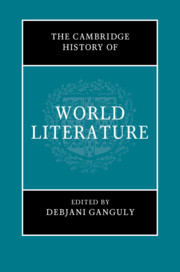Book contents
- The Cambridge History of World Literature
- The Cambridge History of World Literature
- Copyright page
- Contents
- Figures
- Contributors
- Acknowledgements
- Introduction
- Part I Genealogies
- Part II Thinking the World
- Part III Transregional Worlding
- Part IV Cartographic Shifts
- Part V World Literature and Translation
- 27 Translating Iconoclasm: Sino-Muslim Azharites and South-South Translations
- 28 The Avant-Garde Journal between Maghreb and Levant
- 29 The “Forgers” of World Literature: Translation, Nachdichtung, and Hebrew World Poetry
- 30 World Literature as Process and Relation: East Asia’s Russia and Translation
- Part VI Poetics, Genre, Intermediality
- Part VII Scales, Polysystems, Canons
- Part VIII Modes of Reading and Circulation
- Part IX The Worldly and the Planetary
- Index
- References
27 - Translating Iconoclasm: Sino-Muslim Azharites and South-South Translations
from Part V - World Literature and Translation
Published online by Cambridge University Press: 17 August 2021
- The Cambridge History of World Literature
- The Cambridge History of World Literature
- Copyright page
- Contents
- Figures
- Contributors
- Acknowledgements
- Introduction
- Part I Genealogies
- Part II Thinking the World
- Part III Transregional Worlding
- Part IV Cartographic Shifts
- Part V World Literature and Translation
- 27 Translating Iconoclasm: Sino-Muslim Azharites and South-South Translations
- 28 The Avant-Garde Journal between Maghreb and Levant
- 29 The “Forgers” of World Literature: Translation, Nachdichtung, and Hebrew World Poetry
- 30 World Literature as Process and Relation: East Asia’s Russia and Translation
- Part VI Poetics, Genre, Intermediality
- Part VII Scales, Polysystems, Canons
- Part VIII Modes of Reading and Circulation
- Part IX The Worldly and the Planetary
- Index
- References
Summary
This chapter takes up a small part of the writings of a group of Muslim intellectuals from China who studied at Al-Azhar University in Cairo in the 1930s and 1940s and worked to think through the connections between China, Islam, the Arab world, and literatures in Chinese and Arabic. Through a close reading of Recollections of Childhood (Tongniande huiyi), Ma Junwu’s translation of the first volume of Taha Husayn’s The Days (al-Ayyām), we see how the Sino-Muslim Azharites provide a valuable historical example and theoretical resource for our own scholarly practice at a time when attempts to go beyond the boundaries of national literatures and languages default all too quickly to monolingual approaches.
- Type
- Chapter
- Information
- The Cambridge History of World Literature , pp. 513 - 526Publisher: Cambridge University PressPrint publication year: 2021



